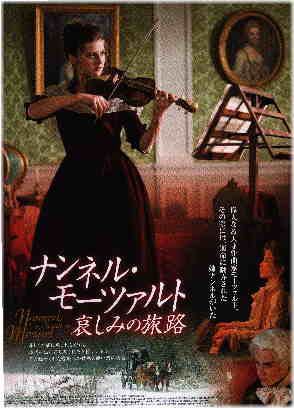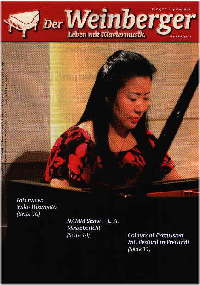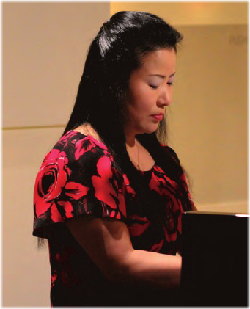久元祐子 記事
2011
| 掲 載 年 |
| 2012年 |
| 2011年 |
| 2010年 |
| 2009年 |
| 2008年 |
| 2007年 |
| 2006年 |
| 2005年 |
| 2004年 |
| mostlyclassic |
| 2003年 |
| 2002年 |
| 2000年 |
| 1999年 |
| 1998年 |
| 1997年 |
| 1996年 |
2011年
- 「モーツァルトの姉は才能を封印した?」 久元祐子
- 映画 『ナンネル・モーツァルト 哀しみの旅路』
Nannnerl la Soeur de Mozart プログラム (2011年4月)
マリア・アンナ・モーツァルト、通称ナンネル。モーツァルトより5歳年上の姉。 彼女は、天才モーツァルトとともに生きた脇役の一人に過ぎない。もちろん彼女の作品も伝えられていない。
その彼女が、実は優れた音楽家であり、作曲家としての才能にも恵まれ、優れた作品を書いていた ― この映画は、充分にあり得たであろうナンネルのもうひとつの可能性を描く。
ナンネルは、優れたクラヴィーア奏者、現代で言えばピアニストであった。この時代、当時「クラヴィーア」と総称された鍵盤楽器は、チェンバロから今のピアノの前身であるフォルテピアノへと移り変わっていく。この映画が描いている1760年は、まだチェンバロが弾かれていて、ナンネルとモーツァルトの姉弟は、チェンバロを連弾し、ヨーロッパ中で拍手喝采を受けていた。
モーツァルトは、クラヴィーア演奏家としての姉の才能を認め、彼女のためにクラヴィーア協奏曲やカデンツァを作曲している。また、モーツァルトは、旅先やウィーンに移り住んでからも、自作をナンネルに送ったり、彼女に演奏上のアドバイスを与えたりしている。姉の音楽への感性や趣味を信じ、評価していたからだろう。
モーツァルト姉弟の父レオポルトは、ザルツブルクの宮廷に仕える副楽長で、優れた教育者でもあった。《ナンネルの楽譜帳》という愛称で知られる曲集は、ナンネルのためにレオポルトが編んだ練習曲集である。原本には、「チェンバロのために、この楽譜帳はマリア・アンナ・モーツァルト嬢のためのもの。1759年」と記されている。
弟が生まれ、チェンバロやオルガンに触れるようになるにつれ、レオポルトは弟の中に天才的な才能を見いだした。そして姉の方は次第に脇役に追いやられていった。それは、姉の音楽的才能が弟より劣っていたからだ、というのが後世の受け止め方だが、果たして本当にそうだったのか。
レオポルトは、どうすれば貴顕の人々を音楽で喜ばせ、取り入ることができるかを知っていた。この時代、女性が作曲家になることはあり得なかったし、受け入れられなかった。姉がいかに弟と等しい才能に恵まれていたとしても、ナンネルを作曲家として世に出すことは無理だった。レオポルトは、モーツァルト家の将来を弟に託すことにし、ナンネルを音楽の舞台から遠ざける。映画の中で彼女が自らの作品を暖炉の火の中に投じ、燃やすシーンが出てくるが、この場面は、ナンネルが父の意向を受け入れ、自らの才能を封印したことを象徴しているのだろう。
母がパリで不遇のうちに亡くなった後、老いゆく父を世話したのはナンネルだった。レオポルトはなかなか彼女を手放そうとはせず、33歳になったナンネルが嫁いだ相手は15歳年上で、すでに5人の子供がいた。
ウィーンで頭角を顕していくモーツァルトとナンネルの間には、次第に溝が出来ていったようだ。ナンネルは、嫁ぎ先からしばしば父を見舞い、看病するが、モーツァルトは、父レオポルトの死にも、葬儀にも立ち会うことはなかった。かつてチェンバロを連弾し、喝采を浴びた姉弟は、父の遺産相続をめぐり、冷たく、事務的な手紙を交わす。モーツァルトが35歳で早逝したときも、ナンネルが弟の葬儀に出向くことはなかった。夫に先立たれたナンネルは故郷のザルツブルクで晩年を過ごし、1829年、78歳の長寿を全うした。
ナンネルが世を去ってまもなく、女性が演奏家としてのみならず作曲家としても活躍する時代がやってくる。メンデルスゾーンの姉のファニー、そしてシューマンの妻クララは、すぐれたピアニストであり、主としてピアノのための作品を作曲し、演奏して、人々を魅了した。本格的なピアノの時代がやってきて、女性音楽家に活躍の舞台を提供できる時代の到来だった。
ナンネルがもしこの時代に生きたとしたら、彼女の人生、そして後世の評価は、まったく別のものになったのかもしれない。
『ナンネル・モーツァルト 哀しみの旅路』プログラム

- ♪ 諏訪響、150回目の定期公演
- (信濃毎日新聞 2011年5月10日)
岡谷で14日「炎のコバケン」招き
アマチュアオーケストラとして国内最古の歴史を誇る諏訪交響楽団は14日、岡谷市カノラホールで150回目の定期演奏会を開く。節目を記念し、日本フィルハーモニー交響楽団の元音楽監督で、「炎のコバケン」の愛称で知られる小林研一郎さん(71)=東京都新宿区=を初めて指揮者に招く。
「演奏通じて勇気を届けたい」
諏訪響は、茅野市民館で毎年恒例の「信毎春休みファミリーコンサート」などでこれまで何度か演奏し、小林さんとも共演した経験があるピアニスト久元祐子さん=同=らを介して小林さんに指揮を依頼。小林さんは「今は文化事業を続けるのが難しい時代で、150回も定期演奏会を重ねたアマチュアは知らない。わくわくしている」と話す。
演奏するのはラフマニノフのピアノ協奏曲第2番と、チヤイコフスキーの交響曲第5番の2曲。ともにロシアを舞台に作られ、困難に立ち向かう曲という。久元さんがピアノを担当し、楽団員や身内の演奏家ら約90人が出演する。
8日、カノラホールで行った練習には小林さんが加わり、初めて団員たちを前に指揮棒を振った。小林さんは何度も演奏を止めながら「大地をのたうち回るような感じを出して」 「もっと弓をしならせて」などと精力的に声を掛けた。12、13日にも小林さんの指揮でリハーサルを予定している。
小林さんの出身地・福島県いわき市は東日本大震災で被災。演奏会では収益の一部を同県をはじめ被害の特に大きかった宮城、岩手各県のオーケストラや被災者に義援金として贈る予定だ。理事長の丸茂洋一さん((50)=茅野市玉川日=は「演奏を通じて困難に立ち向かう勇気を届けたい」と話す。
諏訪響は1925(大正14)年に発足し、翌26年に第1回演奏会を開催。現在は、毎週木曜の夜に諏訪市文化センターで練習し、春と秋に定期演奏会を開いている。ことし3月に予定した春休みファミリーコンサートは震災の影響を考慮して中止になったが、団員たちは気持ちを新たに、定期演奏会に向けて集中してきた。丸茂さんは「小林さんとの出会いで、一段階上に進めるのではないか」と期待を込めている。
午後6時半開演。入場料は前売りが一般2500円、高校生以下千円。当日はともに500円増し。問い合わせは事務局の小口さん(昔090 ・8723・0513)へ。
信濃毎日新聞 11.5.10 記事(pdfファイル)
- Yuko Hisamoto im Boesendorfer - Interview
 (Weinberger Fruhling 2011)
(Weinberger Fruhling 2011)
Weinberger Fruhling 2011 記事(pdfファイル)
- ♪ ステージ上で堪能 ピアノ名器の響き 諏訪 久元さんが演奏会
- (長野新報 2011年6月12日)
諏訪市音楽協会(榛葉和子会長)は11日、同市駅前市民会館で国立音楽大学准教授でピアニストの久元祐子さんのピアノコンサート「ステージで聴くベーゼンドルファー」を開いた。約100人がステージ上で鑑賞し、目の前で弾かれるしなやかな響きを堪能した。
コンサートは「天才モーツァルトの学習と創造をたどる」をテーマにレクチャーリサイタルの形式で行い、演奏の合間には久元さんがモーツァルトの作品を解説した。ピアノ・ソナタ変ホ長調KV282の演奏を終えた久元さんは「天才といわれるモーツァルトですが、体の中に音楽を取り入れることで音楽を作ってきた」と説明した。
同会館が常設するグランドピアノは欧州を代表するピアノメーカーのベーゼンドルフファー社製で、1987年に同市出身の実業家の兄弟から寄贈された。
名器と呼ばれる同社製ピアノの持ち味を多くの人たちに知ってもらうために、ベーゼンドルファー弾きとして定評がある久元さんを招いて行った。当初は3月12日に予定していたが、東日本大震災の発生を受けて延期され、今回チャリティーコンサー卜と位置付けて行った。(倉田高志)
長野新報 11.6.12 記事(pdfファイル)
- ♪ 歴史的名器お披露目
- (長野新報 2011年8月6日)
演さん購入のスタインウェイ 久元さんが演奏
諏訪交響楽団音楽監督、常任指揮者を務める日本精機工業社長の濱さん=諏訪市中洲=がウィーンで購入した1939年製のピアノ「ハンブルグのスタインウェイ タイプD」のお披露目コンサートが5日、同社サロンで聞かれた。濱さんと親交のあるピアニスト・久元祐子さんが演奏。関係者らが聴講し重厚な音色に聴き入った。ピアノは「ウィーンの歴史的文化財」といわれ、コンサートには無料で貸し出し、「ウィーンの文化を諏訪で引き継ぎ、音楽の発信地にしたい」としている。
演さんは2月、ウィーンにピアノを買い求めに行った久元さんに同行。偶然訪れたピアノリペア名門店で、同ピアノと04年製の「ベーゼンドルファー モデル210」と出合い、「音楽の神様が授けてくれた縁」と、その場で2台の購入を決めた。いずれもウィーンのコンツェルトハウスで活用され、世界的ピアニストの巨匠が活用した。
お披露目したスタインウェイの鍵盤は象牙とコクタン。常に良好な状態が保たれていた。久元さんはベートーベンの「エリーゼのために」、ショパンの「ノクターン」、シューマンの「トロイメライ」など作品の背景や作曲家のエピソードを交え、優雅にダイナミックに演奏。演奏後は「ピアノは生きもの。巨匠の魂や気をもらい、様々な音色で心のひだを表してくれる」と語った。
聴衆の一人でインドネシアエプソン元社長の渡辺和義さんは、「素晴らしい名器を諏訪の地に持ってこられたことに敬服。久元さんの心に染み入る演奏で魂が入った」と余韻に浸っていた。
ピアノとサロンは無料で貸し出し、調律は使用者に負担してもらう。問い合わせは日本精機工業(電話53・3400)へ。 (宮坂早苗)
長野新報 11.8.6 記事(pdfファイル)
- ♪ 話題の人から、『ムジカノーヴァ』読者へ宛てたメッセージ
- (ムジカノーヴァ 2011年11月号)
5回シリーズの演奏法講座が一巡したとき、「もう1回このシリーズ を!」とのお話をいただき、続編を行いましたが、さらに続きを、ということでヽ『続々、一歩上を目指すピアノ演奏法』となった次第です。「一歩上を目指す」と銘打っているのは、一人ひとりの受講生のみなさんにとって毎回必ず何か新しく得るものがあり、それを演奏に生かしていただけるような講座にしたいという気持ちからです。
毎回の講座では、スコアの読み方、曲の形式や分析、私なりの解釈にも触れますが、鍵盤上の指の動きをスクリーンに大写しにし、お話と演奏が一体となって、一つひとつの曲を楽しんでいただきたいと思います。楽器からもっともふさわしい音色を引き出すアプローチを試みたいと思います。
今回、バッハ、モーツァルト、リストをとりあげます。「続々」ということで、これまでの受講生の方も数多く参加してくださると思いますが、初めての方もお気軽に参加していただけましたら幸いです。
ムジカノーヴァ11月号(pdfファイル)
- A Human warmth
- Boesendorfer (No.6/ December 2011)

The pianist Yuko Hisamdto plays over 60 concerts per year in her native Japan as well as abroad.In addition to performances with numerous orchestras, such astheTokyo Philharmonic Orchestra, the Philharmonic Orchestra of Japan, and the Latvian National Symphony Orchestra, she plays numerous chamber music concerts with ensembles such as the Berlin String Quartet and the Sawa Quartet.
In addition to numerous CD recordings, Yuko Hisamoto has published several books on Mozart research (including"Re- search on Mozart's Piano Music and How did Mozart Play"). As a pianist, she is the recipient of the Sonoda-Takahiro Prize and the Mainichi 21st Century Prize. In addition to her con- cert activity, she works as a professor at the renowned Kuni- tachi College of Music and is a board member of the Latvian Institute of Music in Japan. In an interview with Simon Oss (Bosendorfer), she discusses her life as a pianist, her inter est in Mozart, as well as her very special relationship with Bosendorfer.
BOSENDORFER: What memories do you have of your first en counter with a piano?
Yuko Hisamoto: I remember very clearly how beautiful it was when my first piano, a Yamaha, was delivered. I was three years old at the time. My grandmother played the koto. Dur ing my childhood, I often listened to my grandmother and mother play music and then I imitated the folksongs and dances on the piano. Actually, I also wanted to learn to play the koto on the side, but the hand movements turn out to be completely different, so I therefore decided to concentrate on the piano.
BOSENDORFER: You have already played in the presence of the Emperor and Empress. What significance does this have for you as a Japanese?
Yuko Hisamoto: It was my great honour for me to have the opportunity to play in the presence of the Japanese royal couple, Emperor Akihito and Empress Michiko. Afterwards, the Empress asked me sev eral questions, with great interest, such as how to produce a beautiful tone. This was, of course, a very special moment. Thanks to the piano - it was a Pleyel from 1840 - I received this honour. The Empress is a music lover and plays piano very well herself. And she even received a Bosendorfer grand piano as a wedding gift and loves to play it.
BOSENDORFER: You have taught piano, chamber music and repertoire at the Kunitachi College of Music for some time. Why did you choose to teach in addition to your active concert life?
Yuko Hisamoto: Everything started about seven years ago, when the director of the university attended one of my concerts. She listened with great interest and then offered me a position as associate professor. She definitely wanted an associate professor who was not only a pedagogue, but first and foremost an active pianist. Yet at first I didn't want to take on this position since I wanted to concentrate 100% on my activity as a pianist. Of course, I then deliberated for a long time and a friend of mine, who is a clarinet profes sor himself, said to me,"A good musician need not be a good pedagogue, but a good pedagogue must be a good player." These thoughts resonated with me and this is how I decided to accept the pedagogical position.
BOSENDORFER: You have also written several books on Mozart. Where does your love of this composer come from?
Yuko Hisamoto: The mystique of Mozart and his music - that's of course a limitless field. Yet what is really interesting to me is his sketches and paraphrases. Reading what's be tween or behind the notes, the deeper meaning, discovering or engrossing oneself in the spirit of Mozart - that's really interesting.
After Mozart came, of course, numerous composers who used lots more notes and complicated, multifaceted harmo nies. Yet Mozart continues to be unique. How he was able to create music of an entirely different character with just a few notes and even with a unique change in tone! In Japan, there are lots of books on Mozart. However, Mozart is mostly simply revered in these books and people feel that Mozart is holy and untouchable. I wish to present another portrait of Mozart, though. Of course he's a genius, yet his predecessors and contemporaries need to be taken into consideration in order to understand Mdzart. For example, Joseph Haydn's Sonata, Hob. XVI:23, very strongly influenced the first six of Mozart's piano sonatas. Mozart's Sonata No. 2 is even in the same key, F major. However, although this same key underlies both sonatas and there are many similarities, when playing both sonatas you immediately have the feel ing of Mozart, which is highly personal and independent of Haydn. The melodic and harmonic construction is well be yond that of Haydn in some passages.The dynamic markings are almost absent in Haydn, yet with Mozart every little nu ance is clearly written out.
BOSENDORFER: At Bosendorfer Hall, you played Beethoven's "Waldstein" Sonata in addition to works by Mozart. What do you find especially interesting about this work?
Yuko Hisamoto: Beethovenrs "Waldstein" Sonata appears to me to be the most mature of Beethoven's 32 sonatas. Of course, the later sonatas, such as Op. 111, are practically a world cultural heritage. Yet from a historical perspective, shortly before the "Waldstein" was completed, Beethoven wrote his will in Heiligenstadt, the Heiligenstadt Testament. At the time, he had already faced death once and I feel how the composer looked back upon his entire life up to that point and put his whole spirit into this work. And whenever I play this piano sonata, I always feel a strong human spirituality. Not only the compositional structure, but really the strength of the person despite all obstacles and dif ficulties. He is deeply affected by his disease, yet he pushes through this obstacle and goes on with his life. The second movement ends on G and the third movement begins with this note. Yet while I primarily feel sorrow, pain, hopelessness and total desperation in the second movement, everything is overcome in the third movement, and rays of sunlight break through the mist.
BOSENDORFER: You are also a historical instrument specialist. Where is your interest focused?
Yuko Hisamoto: I am highly interested,for example, in a piano by Walter, which is an instrument that was contemporaneous with Mozart. Due to this sound and the piano's action, I feel the aesthetic thoughts with which Mozart composed this piece at the time. I'm best able to realize these aesthetic thoughts on a modern Bosendorfer grand. Back then, the touch was of course completely different, and the key depth was also a lot shallower. You only had 5 or 6 mm of key depth at the time.Today it's about 10 mm.The action was also much finer compared to today's instruments, and it's thereby much easierto play ornaments and trills in the style of Mozart's era compared to the modern piano. Of course, the modern piano is far superior in terms of dynamic differentiation or colour spectrum,yet this fineness and ease that was preferred dur ing Mozart's time are much more difficult to implement with the modern piano. Whenever I play a historical instrument, I learn from its specific feel to make due with modern instruments, and that's very exciting. I also own a historical Bosendorfer from 1828-1829, which was thus built by Ignaz Bosendorfer himself. I'm always in spired by this piano; in it I feel the extensive and great tradi tion of the art of piano building. This aesthetic tradition that Bosendorfer has inherited and the endless continued devel opment that this manufacturer has simultaneously made is something that fascinates me. Owning this very old grand piano is an indescribable feeling. I also own a Bosendorfer model Johann Strauss from 1911 and a Bosendorfer upright piano. I'm fascinated by the true Viennese tradition of sound, with its beauty.
BOSENDORFER: You recently also acquired a new Imperial. How would you com pa re your piano from 1828 - 1829 and the various instruments from which you just selected?
Yuko Hisamoto: Of course we experience technological changes; for instance, we no longer drive with a horse and carriage but rather with express trains, cars and airplanes,or even into outer space with rocket ships. Yet through music, when listening or playing, we always seek the innerfeelings from the depths of our heart and evoke them. Bosendorfer pianos can do this especially well - they best match my playing. This time, I had four different Imperials from which to choose, and all of them were true individuals, yet all four had something wonderful in common: they speak directly to the human heart. Of these various Imperials, one was re ally sensitive, with lightness, another had a very tight sound, yet all are spiritual instruments and these differences make them all the more interesting. That's how you recognize handcraft.
BOSENDORFER: What is your opinion on the different sounds and varieties of touch of the various manufacturers?
Yuko Hisamoto: I find the instruments of some manufactur ers to be like Formula race cars, with unbelievable speed and power. In a large hall with orchestra and 2000 concertgoers this probably has its advantages. The sound travels far and wide through metallic effects, yet it also sounds like a ma chine. Yet with Bosendorferyou feel more of the warmth of the human body.The finest feelings, nuances and simultane ously unbelievable depth and colour variation are possible. I can even express the smallest sentiments with it.That's why the Bosendorfer is my best friend, my beloved.
記事 2010 へ